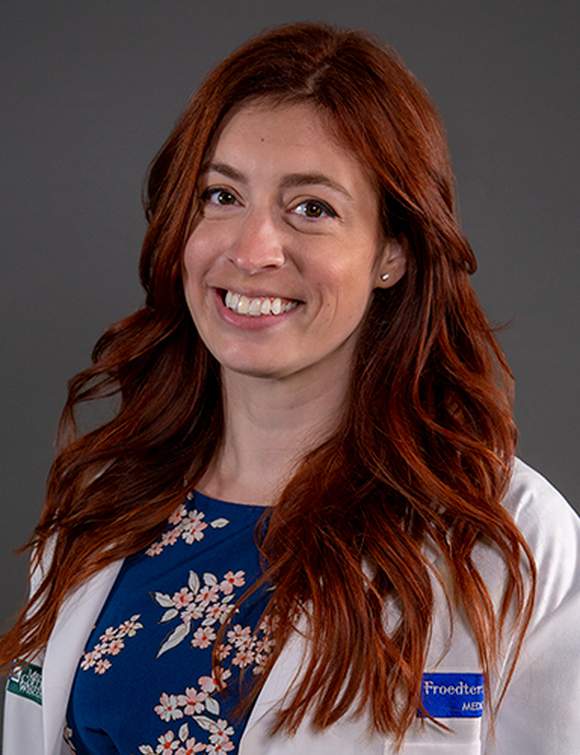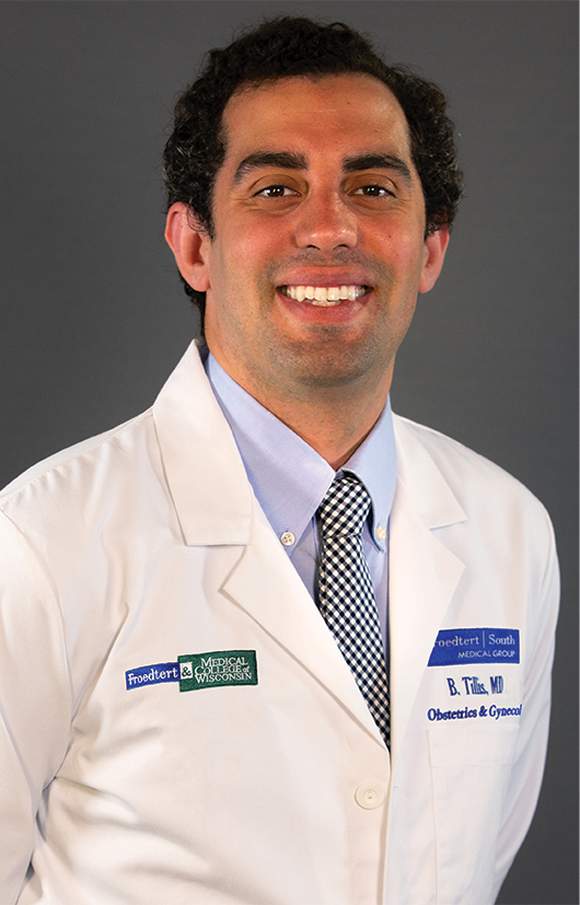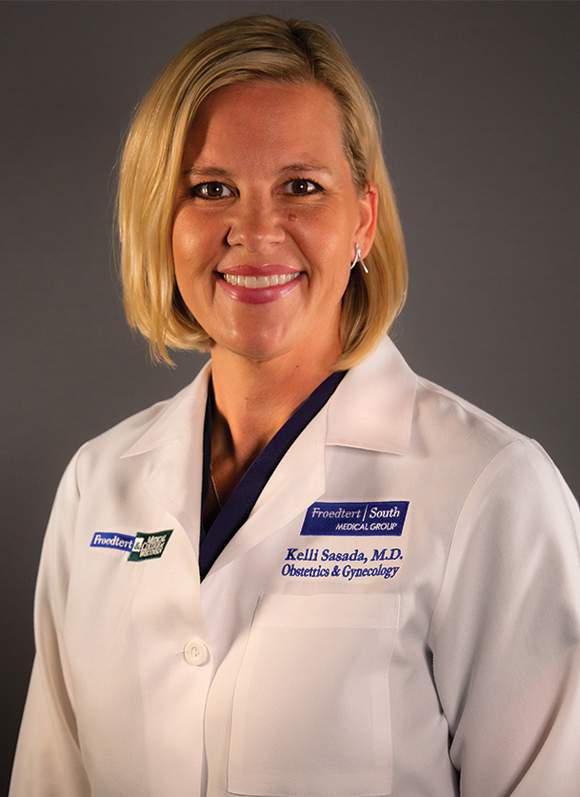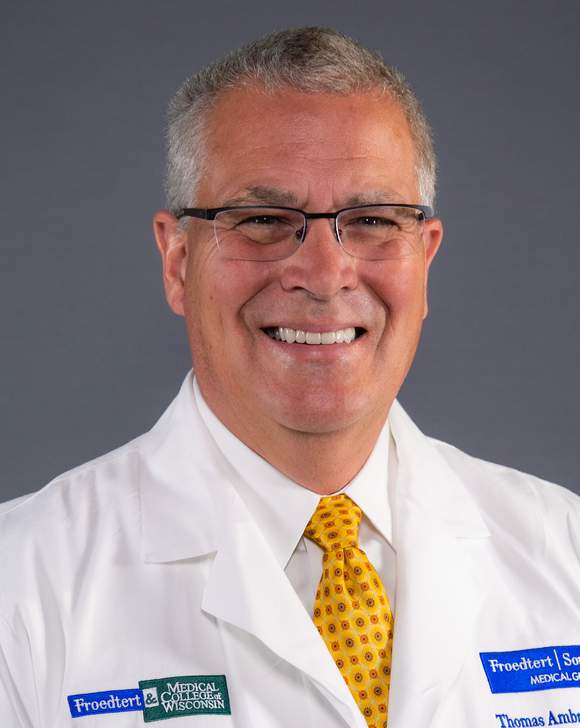Women’s health. It’s been defined as “a state of complete, physical, mental and social wellbeing, not merely the absence of disease.” At Froedtert South, that vision guides our wholistic approach to all our Women’s Health Services, including pregnancy, labor and delivery in our extraordinarily comfortable and safe Birthing Inn, breast and gynecological cancer screenings, routine Well Woman exams, robotic-assisted and other minimally-invasive procedures, and more. All right here, close to home. We asked four obstetrician/gynecologists on our Women’s Health Services team to reflect on some of the important things related to women’s health that they want people in our community to know more about.

Caroline Bednarski, MD: Obstetrician/Gynecologist
There’s no reason to fear your first appointment with a gynecologist
When should a woman see a gynecologist for the first time? As one of the younger doctors in our office, I see some of our youngest patients, so it’s a question I’m accustomed to answering. Here’s what I recommend: We want to start performing pap smears to screen for cervical cancer when women turn 21 years of age, so a woman who has not seen a gynecologist to that point should certainly see one soon after her 21st birthday. Women under the age of 21 should see a gynecologist if they develop a menstrual issue, such as irregular or painful periods, or if they are sexually active. The first thing I tell a patient seeing me for the first time is that they don’t need to worry about having a pelvic exam at their first appointment. I think that is where most of the embarrassment and nervousness comes from, because they’re not sure they’re ready to have a pelvic exam. Most of the time, our first meeting is going to be a conversation. I’m learning what’s bothering a patient about their menstrual cycle and giving them information on whether their cycle is normal or if it’s something that we need to look further into. If a patient hasn’t been sexually active to that point, I don’t require them to have a pelvic exam unless I’m concerned about a specific issue, but that’s really rare. Teenagers who have just started menstruating should know within a year or two if their cycles are going to be normal. Somewhere between 11 and 13 years of age is when we start seeing patients who are experiencing issues. Often, we can regulate those problems with contraception – even with your youngest patients. That’s because after a young woman starts getting her period, there’s no longer a concern about giving her hormones, because her growth plates are already fused. That’s something parents sometimes ask about. Also, some patients I see are surprised that the exam I performed didn’t hurt. It happens all the time. They’ll say, “Oh, that was it? That didn’t hurt at all.” I had a patient recently who was expecting the exam to be painful, but was surprised when it wasn’t. I tell all my patients that pelvic exams are not supposed to hurt. One other misconception that patients sometimes have is that a pap smear and pelvic exam are the same thing. A pap smear is actually only a small component of a routine exam that looks specifically for pre-cancerous cervical cells. A full exam, however, includes an assessment of the patient’s ovaries, their uterus, and menstrual periods – making sure that everything is healthy. That’s why it’s important to have full exams on a regular basis.

Brian Tillis, MD: Obstetrician/Gynecologist
You don’t have to live with excessive bleeding
Abnormal uterine bleeding is something that happens to a lot of women, and one of the most common women’s health issues we see. It’s also something that some patients are initially embarrassed to discuss, or go see a doctor about. That’s unfortunate, because it’s something that can be horribly disruptive to normal life. I’ve had some patients who can’t leave their house for the first three days of their period. They’re missing too many days of work and interrupting their family lives. Coming to see me is the first step toward a solution. I’m happy to see patients whenever they’re ready, but if patients come to see me earlier, we can take care of the problem sooner. Uterine fibroids are a common cause of abnormal bleeding. These are benign growths that can cause heavy, abnormal, and very disruptive bleeding. If diagnosed sooner rather than later, they can be managed less invasively. Another common cause of excessive bleeding is an abnormal menstrual cycle, where the normal ebb and flow of hormones is thrown off. Patients may have months in which they don’t ovulate at all, causing build-up in the lining of the uterus that results in irregular, heavy bleeding. Also, women who have to be on a blood thinner for their long-term health may also experience abnormal bleeding as a side effect. Whatever the cause of their excessive bleeding, we have plenty of treatment options to help women manage it – depending on their circumstances, as well as their personal goals and preferences. We can prescribe medication. We may be able to perform an office procedure to manage the problem. Hysterectomy is also an option for patients who want immediate, final resolution of the issue, or for patients who have tried other options that didn’t produce the results they wanted. One of the great things about our group of doctors is that we are all trained to perform minimally invasive robotically-assisted hysterectomy surgery. This will always be a major surgery, but when it’s robotically-assisted, the incisions are tiny, and the recovery

Kelli Sasada, MD: Obstetrician/Gynecologist
Regular visits with your gynecologist shouldn’t end with childbirth
Once women are past their childbearing years, they’re busy with their kids, or working, or taking care of aging parents, or, often, all of the above. Some think that they no longer need to see their gynecologist, but that’s a mistake. Women who experience problems in their late 40s or 50s may have already missed opportunities to do something about those issues and restore their quality of life. I’m talking about issues such as urinary incontinence, painful intercourse, problems with bowel movements, or cervical prolapse, in which internal organs slide downward into a woman’s lower abdomen. Either because they’re embarrassed to talk about these problems, or they don’t have a primary care physician to refer them to a gynecologist, these issues can fall through the cracks as women choose to live with them. I sometimes have a son or daughter bring in their mother who’s in her eighties and has to wear adult incontinence briefs, who gets chronic urinary tract infections, or has other issues. They ask me, “Can’t you do something for my mom?” The answer is: yes, but the older the patient, the more limited our options. When we’re able to work with patients when they’re younger, there’s more we can do to maintain their quality of life. When one of my patients comes in for her annual exam, I ask if she has any concerns or questions for me. That’s often when I learn that, for example, a patient is wearing incontinence pads all the time because they’re afraid of being embarrassed when out in public. We start the discussion from there, including the many different treatment options we have, such as education, or physical therapy provided by our four trained pelvic floor specialists. We want to make sure all moms come to their postpartum visit with their gynecologist about six weeks after they’ve given birth, so we can talk about some of the issues that may arise years – often decades – after they’ve stopped having babies. After that, I’d like to see a woman once every year or every two years. It’s important for women to continue to see their gynecologist to address the next chapter in their lives after childbirth. There are problems that can arise that we can deal with to dramatically improve a woman’s quality of life.

Tom Ambro, MD: Obstetrician/Gynecologist
Pap smears key to highly-preventable, highly-treatable cervical cancer
Cervical cancer is one of the most treatable cancers in America. If detected early, it can be completely treated – in effect, cured – thanks, in part, to the ready availability of pap smears. A pap smear is a screening test for cervical cancer. A sample of cells is obtained from the surface of a woman’s cervix. That sample is then submitted to our pathology department. A pathologist examines the sample under a microscope to determine if the cells look normal or abnormal. If a pap smear suggests that there could be abnormal or unusual cells, we ask the patient to come back for an office procedure in which we use a special instrument to examine the surface of the woman’s cervix under very high magnification. If we confirm the presence of abnormal cells on the surface of the cervix, we perform a biopsy to determine if the cells are cancerous. If they are, we explore treatment options with the patient based on the stage of the cancer and other factors. One of the things we’ve discovered in more recent years is that a virus called human papillomavirus (commonly called HPV), is responsible for most cervical cancers. Often, with patients 30 years old or older, we do screenings for HPV at the time of their pap smear. An HPV vaccine has been available for many years, and we recommend girls and boys get the vaccine before they become sexually active. One other recent discovery is that pap smears don’t necessarily have to be performed on an annual basis. In general, they can be done every three years until a woman reaches the age of 65.Women between 30 and 65 who also choose to have an HPV screening at the same time of their pap smear may be able to wait five years before their next test. Women who are 65 and older, and who have no history of previous abnormal pap smears, can consider not having pap smears any further. Having said that, there are other very important reasons for women to continue to have annual well-woman examinations with a gynecologist to stay on top of other issues they may have related to safety, contraception, menstrual cycles and other concerns. We don’t want women coming in after three years with a major problem that could have been detected and treated during a routine exam.
All things considered…
Regardless of their stages in life – from adolescence, through child-bearing years, to post-menopause – Froedtert South Women’s Health Services help women achieve and sustain quality of life with breakthrough women’s health care right here, close to home. To learn more, visit www.froedtertsouth.com.
